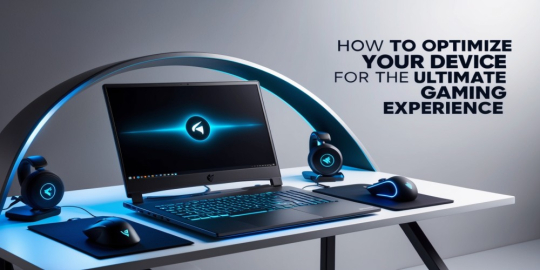
Hey, gamers! Ever feel like your device is moving at the pace of a snail in a tar pit? We've all been there—right in the middle of an intense match, and suddenly, lag spikes hit you like a ton of bricks. Fear not! I'm here to help you squeeze every drop of performance out of your device, so you can game on without a hitch. Let's dive right in and get your setup running smoother than butter.
Update Your Drivers: The Unsung Heroes
First things first—updating your drivers is like giving your device a fresh set of legs. Manufacturers are constantly rolling out updates that fix bugs and enhance performance. Ignoring them is like leaving free power-ups on the table.
Graphics Card Drivers
Your GPU is the heart and soul of your gaming experience. Head over to NVIDIA or AMD's website and snag the latest drivers. Trust me, your frame rates will thank you.
Sound and Network Drivers
Don't overlook your sound and network drivers. Outdated audio drivers can mess with in-game sound cues, and old network drivers might be causing that pesky lag. Keep everything up-to-date to stay ahead of the curve.
Optimize In-Game Settings: Balance Is Key
Cranking everything to ultra settings might seem tempting, but it's not always the smartest move. Tweaking your in-game settings can be a game-changer—pun totally intended.
Resolution and Textures
Dropping your resolution a notch or two can boost performance without sacrificing too much visual fidelity. Adjusting texture quality can also free up valuable resources.
Shadows and Reflections
Fancy shadows and reflections are nice, but are they worth the FPS drop? Probably not. Dial these settings back to gain some extra frames.
Close Background Applications: Less Is More
Running multiple programs while gaming is like trying to juggle while riding a unicycle—it's just asking for trouble. Close unnecessary apps to free up CPU and RAM.
Task Manager Is Your Friend
Fire up Task Manager and see what's hogging resources. End tasks that aren't essential. Be cautious, though—don't shut down system-critical processes!
Disable Startup Programs
Some applications sneak into your startup list and run in the background. Disable them to improve boot times and overall performance.
Upgrade Hardware: When All Else Fails
Sometimes, you just gotta bite the bullet and invest in better hardware. It's like upgrading from a bicycle to a sports car—you'll feel the difference instantly.
Add More RAM
More RAM means better multitasking and smoother gameplay. Aim for at least 16GB if you're into modern titles.
Switch to an SSD
Loading screens got you down? An SSD can drastically reduce load times and make your system snappier overall.
Overclocking: Pushing the Limits
Feeling adventurous? Overclocking can give you that extra edge, but it's not for the faint-hearted. Proceed with caution!
CPU Overclocking
Boost your CPU speed through BIOS settings. Make small increments and test stability each time.
GPU Overclocking
Use software like MSI Afterburner to overclock your GPU. Keep an eye on temperatures to avoid overheating.
Keep It Cool: Temperature Matters
Overheating can throttle your performance faster than you can say "game over." Keeping your device cool is essential.
Clean Your Fans
Dust buildup is the silent killer of performance. Regularly clean your fans and vents to ensure proper airflow.
Invest in Cooling Solutions
Consider getting additional case fans or a better CPU cooler. For laptops, a cooling pad can work wonders.
Update Your Operating System
Running an outdated OS is like playing on an old patch—you're missing out on optimizations and security fixes.
Windows Updates
Enable automatic updates or manually check for updates regularly. These often include performance tweaks.
Disable Unnecessary Visual Effects
Fancy animations and effects can drain resources. Disable them for a leaner, meaner machine.
Use Game Mode Features
Modern operating systems come with built-in game modes designed to optimize performance during gameplay.
Windows Game Mode
Enable Game Mode in Windows settings to prioritize your gaming experience over background tasks.
Third-Party Optimization Software
Software like Razer Cortex can help optimize your system by closing unnecessary processes while you game.
Manage Power Settings
Power settings can throttle your device's performance to save energy. Let's make sure you're getting full power when you need it.
Set to High Performance
In your power settings, select the High Performance plan to ensure your device isn't holding back.
Disable Power Throttling
Some systems throttle performance to reduce heat and save energy. Disable this to keep your device running at full tilt.
Network Optimization: Lag Is the Enemy
Nothing ruins a gaming session like lag. Optimizing your network can be the determinant of triumph or downfall.
Use a Wired Connection
Ethernet connections are more stable and faster than Wi-Fi. If possible, plug directly into your router.
Optimize Wi-Fi Settings
If you must use Wi-Fi, make sure your router is optimized. Use the 5GHz band and minimize interference.
Regular Maintenance: Stay on Top
Keeping your device in tip-top shape requires regular maintenance. It's like changing the oil in your car—you can't just do it once and forget about it.
Disk Cleanup and Defragmentation
Remove unnecessary files and defragment your hard drive to keep things running smoothly.
Antivirus Scans
Malware can wreak havoc on performance. Run regular scans to keep your system clean.
Conclusion: Time to Dominate
There you have it, folks! With these tips under your belt, you're ready to take your gaming experience to the next level. Remember, optimizing your device is an ongoing process. Stay vigilant, keep tweaking, and you'll be the envy of your gaming squad in no time. Now, go forth and conquer!